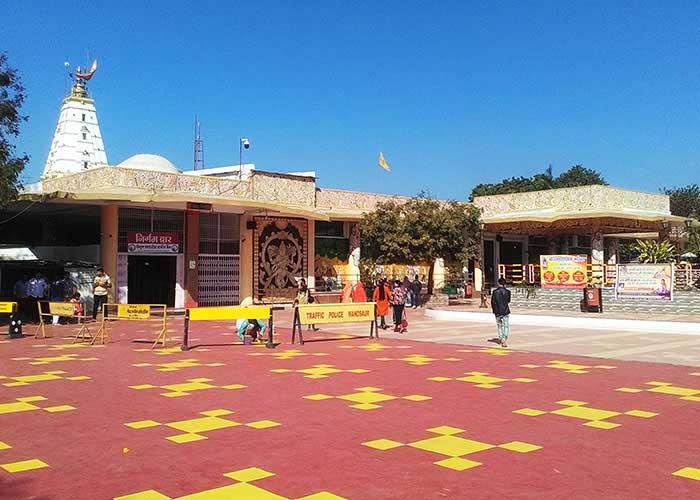Mandsaur Sri Pashupatinath Temple, Madhya Pradesh

Address
Mandsaur Sri Pashupatinath Temple, Pashupatinath Mandir Road, Mandsaur, Madhya Pradesh 458001
Deity
Sri Pashupatinath Amman: Parvati
Introduction
- Location: The temple stands on the banks of the Shivna River in Mandsaur, Madhya Pradesh, India.
- Deity: The primary deity worshipped here is Lord Shiva, in the form of Pashupatinath, “the Lord of the Beasts.” In addition to Lord Shiva, the temple complex also houses idols of Goddess Parvati, Lord Ganesh, Kartikeya, Goddess Ganga, Lord Vishnu, Goddess Lakshmi, and Sage Adi Shankaracharya. A huge idol of Nandi, Shiva’s bull, is also present.
Puranic Significance
- Historical Background: Mandsaur, known as Dashpur in ancient times, lies on the Tropic of Cancer. The name “Mandsaur” is said to have originated from “Mand Surya” (meaning less potent sun), due to its geographical location. The region has been mentioned in several ancient texts, including the Mahabharata, Meghdoot, Puranas, Kadambari, and Brihat Samhita, indicating its rich religious and cultural heritage.
- Pashupatinath Icon: The idol of Pashupatinath in this temple is unique, dating back to the Gupta period, with few parallels— the only other notable comparison being the Pashupatinath Temple in Nepal. Both idols were mentioned in the works of Kalidasa. The name Pashupati is derived from the Sanskrit words “pashu” (animal) and “pati” (protector), emphasizing Shiva’s role as the protector of all beings.
- Tripura Samhar: The mythology of the temple is tied to the legend of Tripura Samhar. Lord Shiva, named Pashupati by Lord Vishnu and other gods, became the destroyer of the three cities of illusion (Tripura), ruled by the asuras Kamlaaksha, Taarakaaksha, and Vidyunmaali, who were causing destruction. The Shiva Purana mentions that those trapped in ego, ignorance, and desires are considered “pashu” (animals), and only Pashupati can liberate them.
- Discovery of the Idol: In 1961, a laundryman named Udaji discovered the idol of Pashupatinath while washing clothes along the banks of the Shivna River. After a series of divine visions, it was revealed that the stone was the idol of Lord Shiva. Despite plans to transport the idol to Ujjain, the cart’s bullocks refused to move, leading to the decision to construct the temple at the site.
Special Features
- Architectural Grandeur:
- The Pashupatinath Temple is known for its striking effigy, made from smooth, dark coppery rock.
- The Shivalinga in the temple is unique, with eight faces— four on the upper section and four on the lower. Each face represents different stages and emotions of life, tied to the directions:
- East: Peace and concentration
- West: Rudra form (anger)
- North: Snakes and hair symbolism
- South: Gentle and artistic expressions
- The Shivalinga is an impressive 2.5 by 3.2 meters, weighing around 4.6 tons.
- The temple stands 101 feet tall, 90 feet long, and 30 feet wide. Golden pitchers weighing 100 kg each adorn the top of the shrine.
- Phenomenon of Jalaabhishek: During the monsoons, the water level of the Shivna River rises to 90 feet, touching the holy Shivalinga. This natural event is referred to as Jalaabhishek (the worship of the Shivalinga with water).
- Mystical Mondays: Mondays are considered particularly auspicious as it is believed that the idol of Lord Shiva emerged from the Shivna River on this day, eventually reaching the Tapeshwar Ghat. The discovery and installation of the deity took place over a period of exactly 21 years, 5 months, and 4 days, marking the incarnation of Pashupatinath, celebrated with grand festivities.
Festivals
- Mahashivaratri:
- The most significant festival at the Pashupatinath Temple is Mahashivaratri, observed with great reverence and devotion. Devotees gather in large numbers to offer prayers and perform rituals, seeking Lord Shiva’s blessings.
- The festival is celebrated on the 13th night/14th day of the Krishna Paksha in the month of Maagha (according to the Hindu calendar).
- Key elements include offerings of Bilva leaves, day-long fasting, and an all-night vigil.
- Kartik Ekadashi: Another important festival is Kartik Ekadashi, celebrated with traditional rituals and devotions.
Century/Period/Age
1000- Years old
Managed By
Archaeological Survey of India (ASI)
Nearest Bus Station
Mandsaur
Nearest Railway Station
Mandsaur Station
Nearest Airport
Bhopal









